Founded in 1938 and published semiannually by Sophia University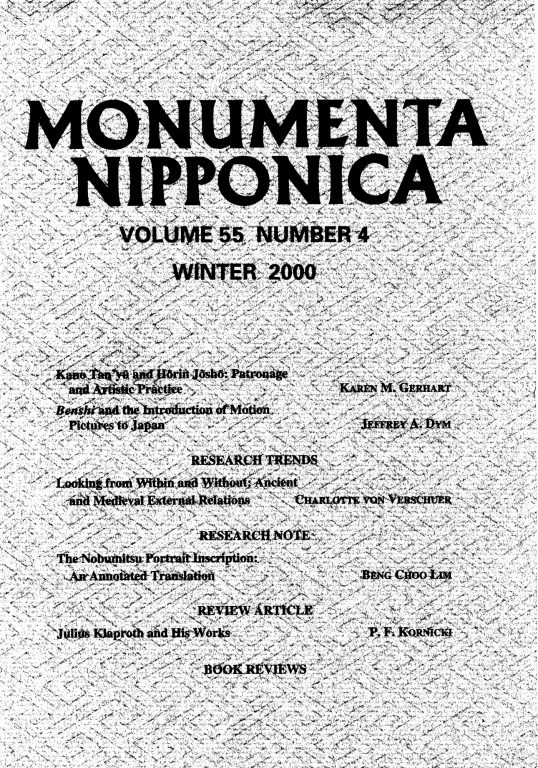 MN 55:4 (2000) 579–591Julius Klaproth and His WorksPeter F. Kornicki
MN 55:4 (2000) 579–591Julius Klaproth and His WorksPeter F. Kornicki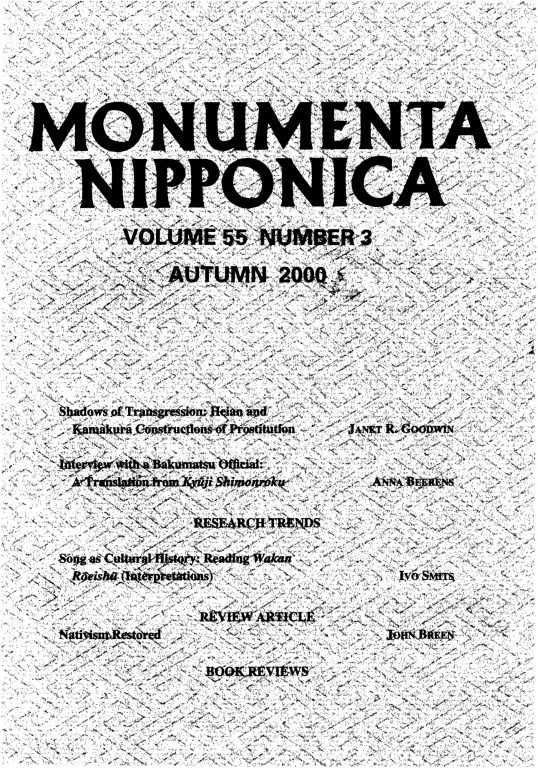 MN 55:3 (2000) 369–98Interview with a Bakumatsu Official: A Translation from Kyūji Shimonroku (Part 1)Anna Beerens
MN 55:3 (2000) 369–98Interview with a Bakumatsu Official: A Translation from Kyūji Shimonroku (Part 1)Anna Beerens MN 55:3 (2000) 374–98The Office of Metsuke: Interview with Yamaguchi Sensho, 16 May 1891Translated by Anna Beerens
MN 55:3 (2000) 374–98The Office of Metsuke: Interview with Yamaguchi Sensho, 16 May 1891Translated by Anna Beerens MN 55:3 (2000) 429–39Nativism RestoredJohn Breen
MN 55:3 (2000) 429–39Nativism RestoredJohn Breen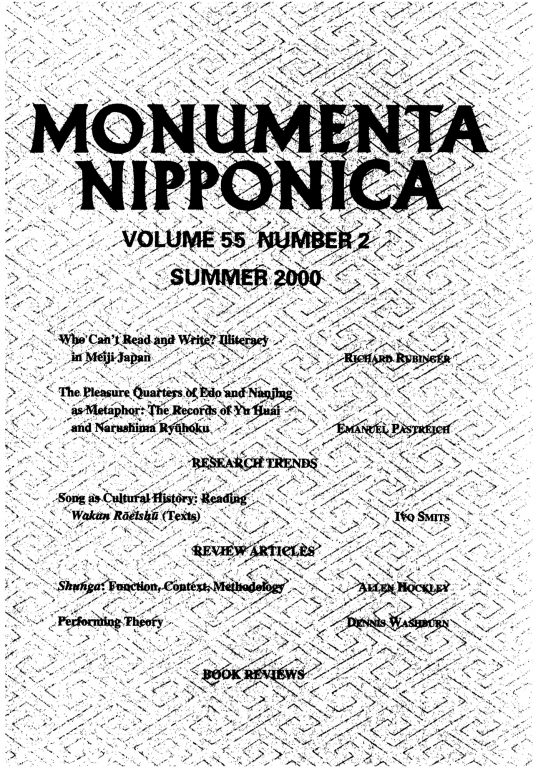 MN 55:2 (2000) 163–98Who Can’t Read and Write? Illiteracy in Meiji JapanRichard Rubinger
MN 55:2 (2000) 163–98Who Can’t Read and Write? Illiteracy in Meiji JapanRichard Rubinger MN 55:2 (2000) 199–224The Pleasure Quarters of Edo and Nanjing as Metaphor: The Records of Yu Huai and Narushima RyūhokuEmanuel Pastreich
MN 55:2 (2000) 199–224The Pleasure Quarters of Edo and Nanjing as Metaphor: The Records of Yu Huai and Narushima RyūhokuEmanuel Pastreich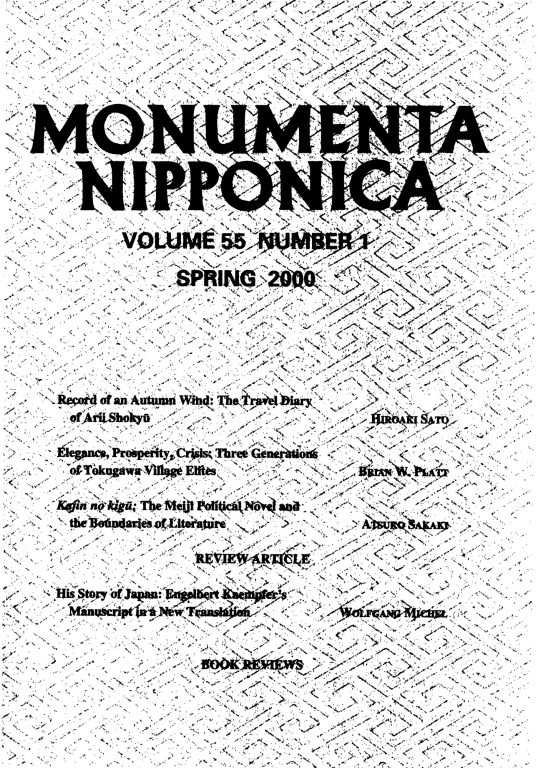 MN 55:1 (2000) 45–81Elegance, Prosperity, Crisis: Three Generations of Tokugawa Village ElitesBrian W. Platt
MN 55:1 (2000) 45–81Elegance, Prosperity, Crisis: Three Generations of Tokugawa Village ElitesBrian W. Platt MN 55:1 (2000) 109–20His Story of Japan: Engelbert Kaempfer’s Manuscript in a New TranslationWolfgang Michel
MN 55:1 (2000) 109–20His Story of Japan: Engelbert Kaempfer’s Manuscript in a New TranslationWolfgang Michel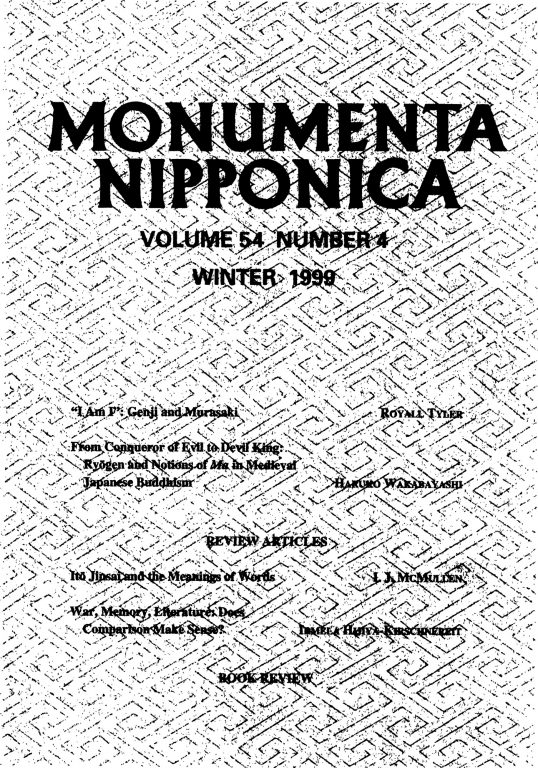 MN 54:4 (1999) 521–528War, Memory, Literature: Does Comparison Make Sense?Irmela Hijiya-Kirschnereit
MN 54:4 (1999) 521–528War, Memory, Literature: Does Comparison Make Sense?Irmela Hijiya-Kirschnereit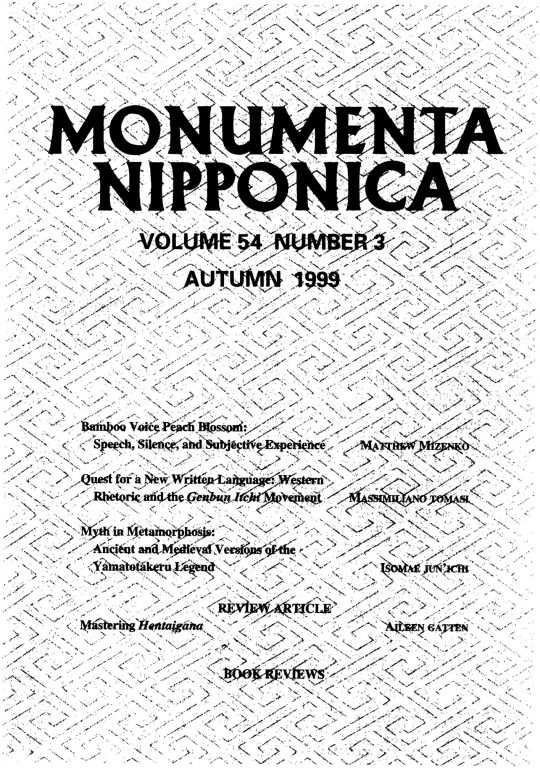 MN 54:3 (1999) 333–60Quest for a New Written Language: Western Rhetoric and the Genbun Itchi MovementMassimiliano Tomasi
MN 54:3 (1999) 333–60Quest for a New Written Language: Western Rhetoric and the Genbun Itchi MovementMassimiliano Tomasi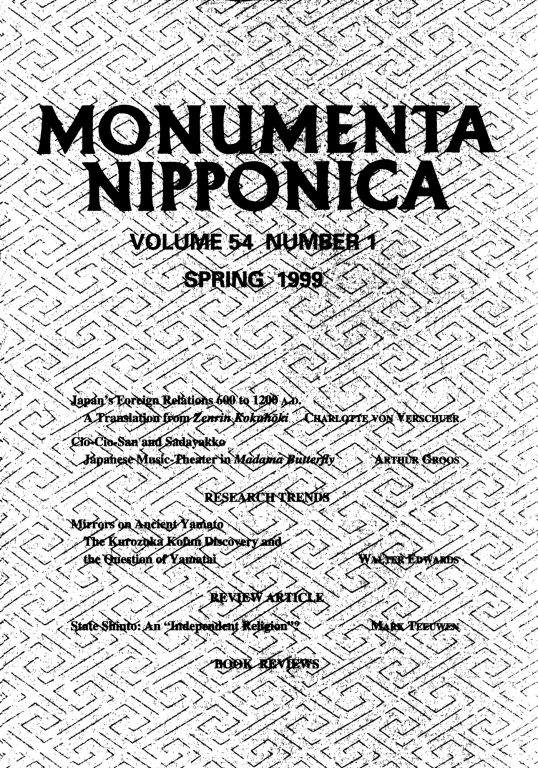 MN 54:1 (1999) 1–39Japan’s Foreign Relations 600 to 1200 A.D.: A Translation from Zenrin KokuhōkiCharlotte von Verschuer
MN 54:1 (1999) 1–39Japan’s Foreign Relations 600 to 1200 A.D.: A Translation from Zenrin KokuhōkiCharlotte von Verschuer MN 54:1 (1999) 13–39Zenrin Kokuhōki (Part 1)Zuikei Shūhō, Translated by Charlotte von Verschuer
MN 54:1 (1999) 13–39Zenrin Kokuhōki (Part 1)Zuikei Shūhō, Translated by Charlotte von Verschuer MN 54:1 (1999) 75–10Mirrors on Ancient Yamato: The Kurozuka Kofun Discovery and the Question of YamataiWalter Edwards
MN 54:1 (1999) 75–10Mirrors on Ancient Yamato: The Kurozuka Kofun Discovery and the Question of YamataiWalter Edwards MN 54:1 (1999) 111–21State Shinto: An “Independent Religion”?Mark Teeuwen
MN 54:1 (1999) 111–21State Shinto: An “Independent Religion”?Mark Teeuwen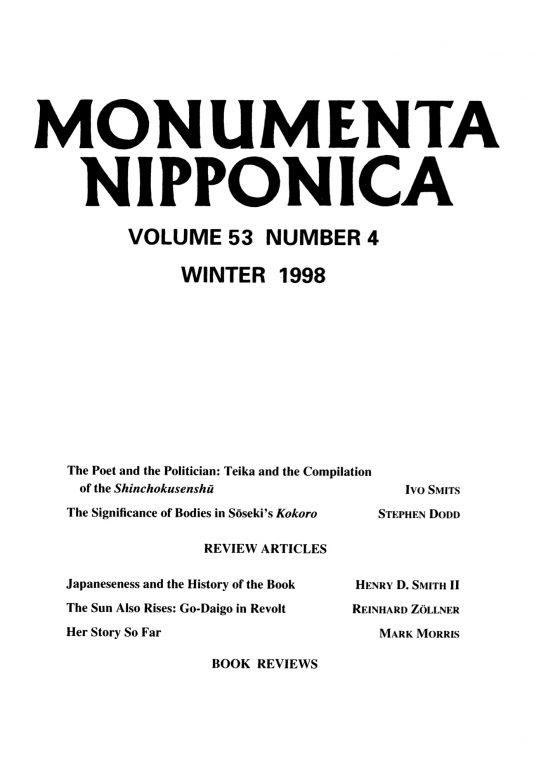 MN 53:4 (1998) 499–515Japaneseness and the History of the BookHenry D. Smith II
MN 53:4 (1998) 499–515Japaneseness and the History of the BookHenry D. Smith II MN 53:4 (1998) 517–527The Sun Also Rises: Go-Daigo in RevoltReinhard Zöllner
MN 53:4 (1998) 517–527The Sun Also Rises: Go-Daigo in RevoltReinhard Zöllner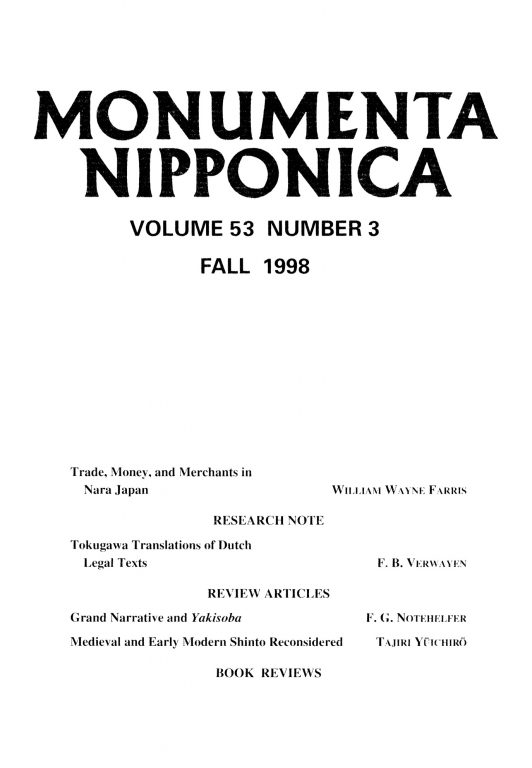 MN 53:3 (1998) 303–34Trade, Money, and Merchants in Nara JapanWilliam Wayne Farris
MN 53:3 (1998) 303–34Trade, Money, and Merchants in Nara JapanWilliam Wayne Farris MN 53:3 (1998) 335–58Tokugawa Translations of Dutch Legal TextsF. B. Verwayen
MN 53:3 (1998) 335–58Tokugawa Translations of Dutch Legal TextsF. B. Verwayen MN 53:3 (1998) 359–73From Grand Narrative to YakisobaF. G. Notehelfer
MN 53:3 (1998) 359–73From Grand Narrative to YakisobaF. G. Notehelfer MN 53:3 (1998) 375–81Medieval and Early Modern Shinto ReconsideredYūichirō Tajiri
MN 53:3 (1998) 375–81Medieval and Early Modern Shinto ReconsideredYūichirō Tajiri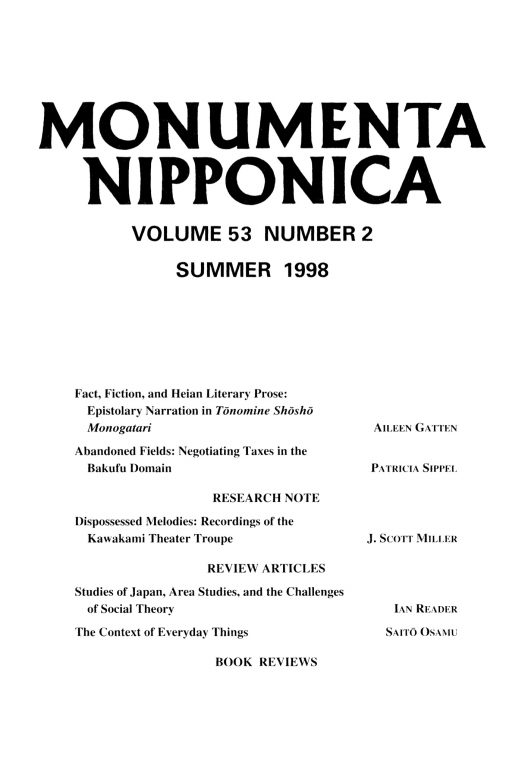 MN 53:2 (1998) 197–223Abandoned Fields: Negotiating Taxes in the Bakufu DomainPatricia Sippel
MN 53:2 (1998) 197–223Abandoned Fields: Negotiating Taxes in the Bakufu DomainPatricia Sippel MN 53:2 (1998) 237–55Studies of Japan, Area Studies, and the Challenges of Social TheoryIan Reader
MN 53:2 (1998) 237–55Studies of Japan, Area Studies, and the Challenges of Social TheoryIan Reader MN 53:2 (1998) 257–63The Context of Everyday ThingsOsamu Saitō
MN 53:2 (1998) 257–63The Context of Everyday ThingsOsamu Saitō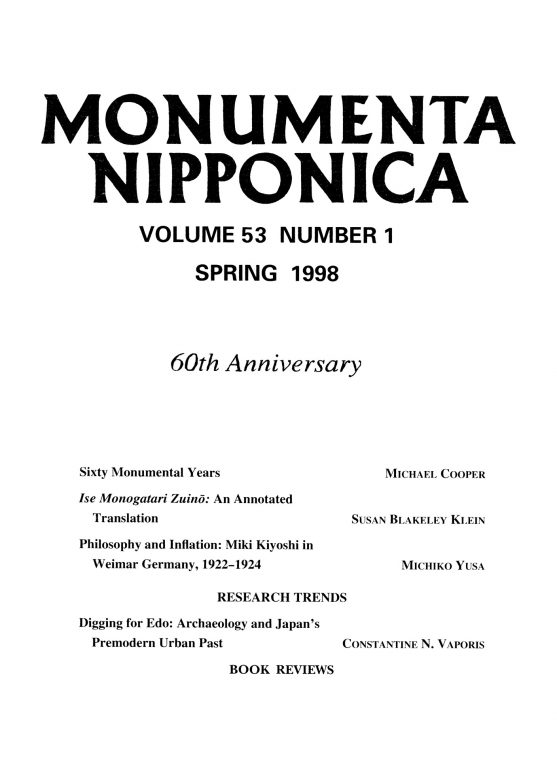 MN 53:1 (1998) 45–71Philosophy and Inflation: Miki Kiyoshi in Weimar Germany, 1922–1924Michiko Yusa
MN 53:1 (1998) 45–71Philosophy and Inflation: Miki Kiyoshi in Weimar Germany, 1922–1924Michiko Yusa MN 53:1 (1998) 73–104Digging for Edo: Archaeology and Japan’s Premodern Urban PastConstantine Nomikos Vaporis
MN 53:1 (1998) 73–104Digging for Edo: Archaeology and Japan’s Premodern Urban PastConstantine Nomikos Vaporis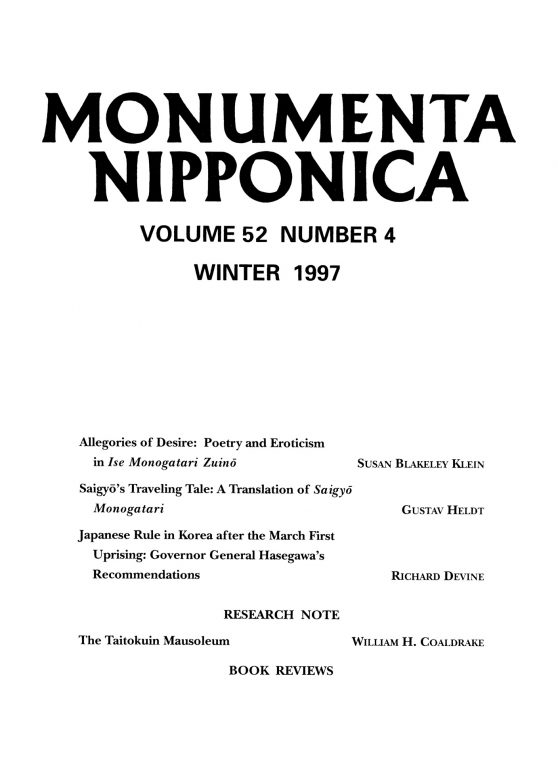 MN 52:4 (1997) 523–540Japanese Rule in Korea after the March First Uprising: Governor General Hasegawa’s RecommendationsRichard Devine
MN 52:4 (1997) 523–540Japanese Rule in Korea after the March First Uprising: Governor General Hasegawa’s RecommendationsRichard Devine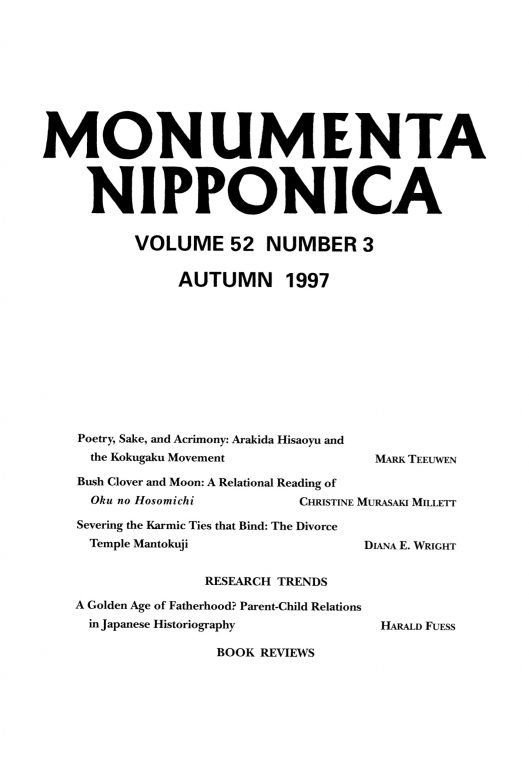 MN 52:3 (1997) 357–80Severing the Karmic Ties that Bind: The “Divorce Temple” MantokujiDiana E. Wright
MN 52:3 (1997) 357–80Severing the Karmic Ties that Bind: The “Divorce Temple” MantokujiDiana E. Wright MN 52:3 (1997) 381–97A Golden Age of Fatherhood? Parent-Child Relations in Japanese HistoriographyHarald Fuess
MN 52:3 (1997) 381–97A Golden Age of Fatherhood? Parent-Child Relations in Japanese HistoriographyHarald Fuess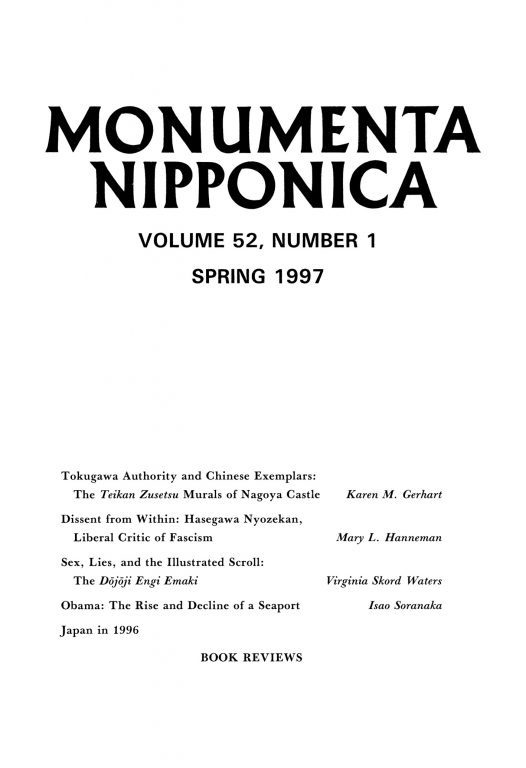 MN 52:1 (1997) 1–34Tokugawa Authority and Chinese Exemplars: The Teikan Zusetsu Murals of Nagoya CastleKaren M. Gerhart
MN 52:1 (1997) 1–34Tokugawa Authority and Chinese Exemplars: The Teikan Zusetsu Murals of Nagoya CastleKaren M. Gerhart MN 52:1 (1997) 35–58Dissent from Within: Hasegawa Nyozekan, Liberal Critic of FascismMary L. Hanneman
MN 52:1 (1997) 35–58Dissent from Within: Hasegawa Nyozekan, Liberal Critic of FascismMary L. Hanneman MN 52:1 (1997) 85–102Obama: The Rise and Decline of a SeaportIsao Soranaka
MN 52:1 (1997) 85–102Obama: The Rise and Decline of a SeaportIsao Soranaka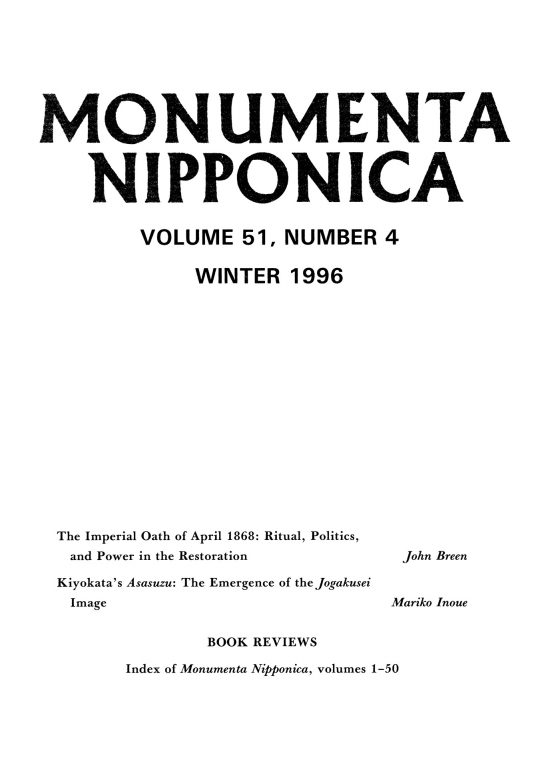 MN 51:4 (1996) 407–29The Imperial Oath of April 1868: Ritual, Politics, and Power in the RestorationJohn Breen
MN 51:4 (1996) 407–29The Imperial Oath of April 1868: Ritual, Politics, and Power in the RestorationJohn Breen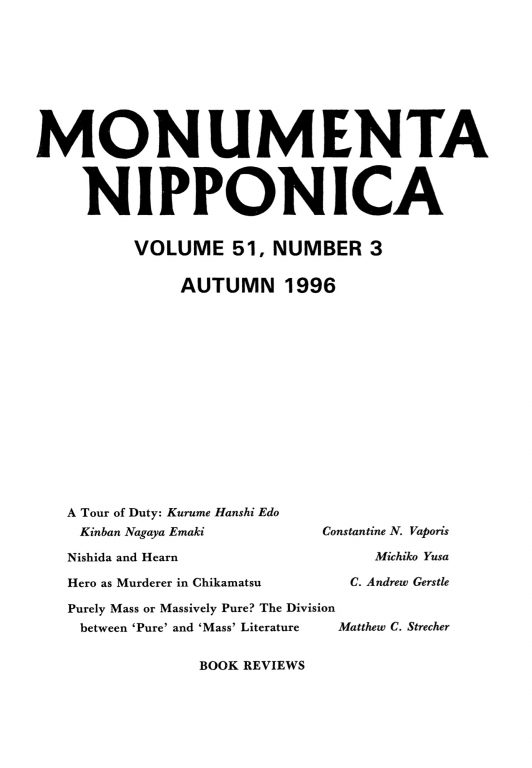 MN 51:3 (1996) 279–307A Tour of Duty: Kurume Hanshi Edo Kinban Nagaya EmakiConstantine Nomikos Vaporis
MN 51:3 (1996) 279–307A Tour of Duty: Kurume Hanshi Edo Kinban Nagaya EmakiConstantine Nomikos Vaporis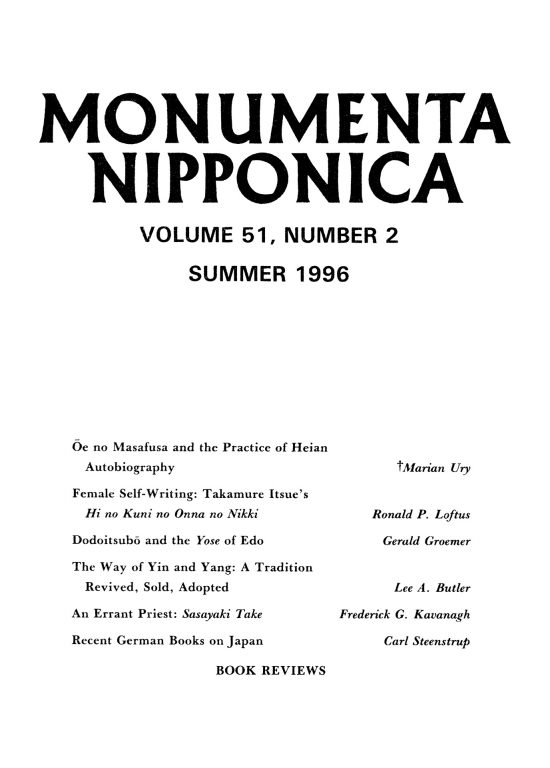 MN 51:2 (1996) 153–70Female Self-Writing: Takamure Itsue’s Hi no Kuni no Onna no NikkiRonald P. Loftus
MN 51:2 (1996) 153–70Female Self-Writing: Takamure Itsue’s Hi no Kuni no Onna no NikkiRonald P. Loftus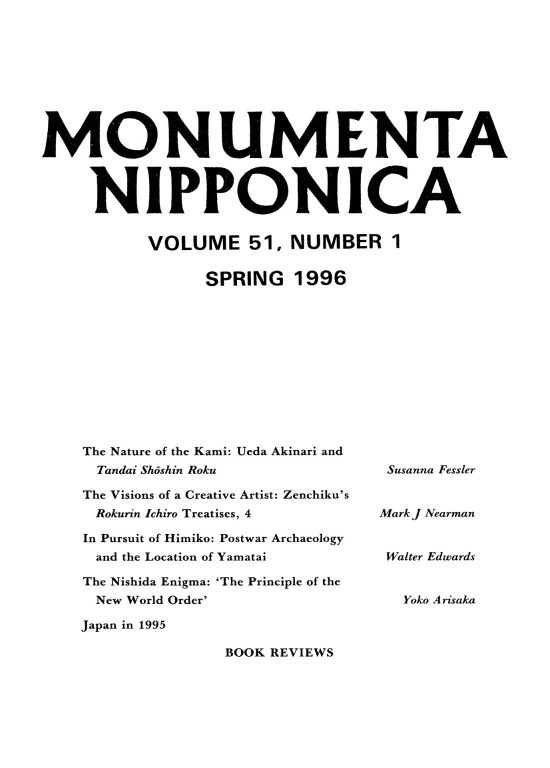 MN 51:1 (1996) 53–79In Pursuit of Himiko: Postwar Archaeology and the Location of YamataiWalter Edwards
MN 51:1 (1996) 53–79In Pursuit of Himiko: Postwar Archaeology and the Location of YamataiWalter Edwards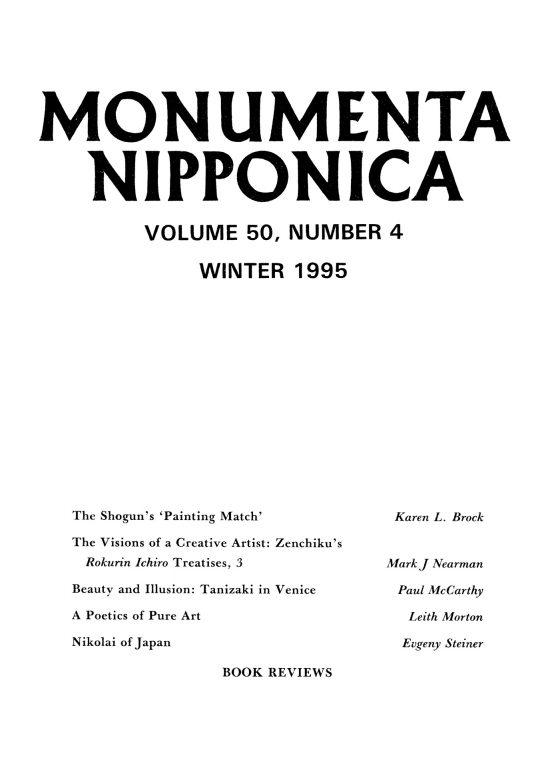 MN 50:4 (1995) 537–550Nikolai of JapanEvgeny Steiner
MN 50:4 (1995) 537–550Nikolai of JapanEvgeny Steiner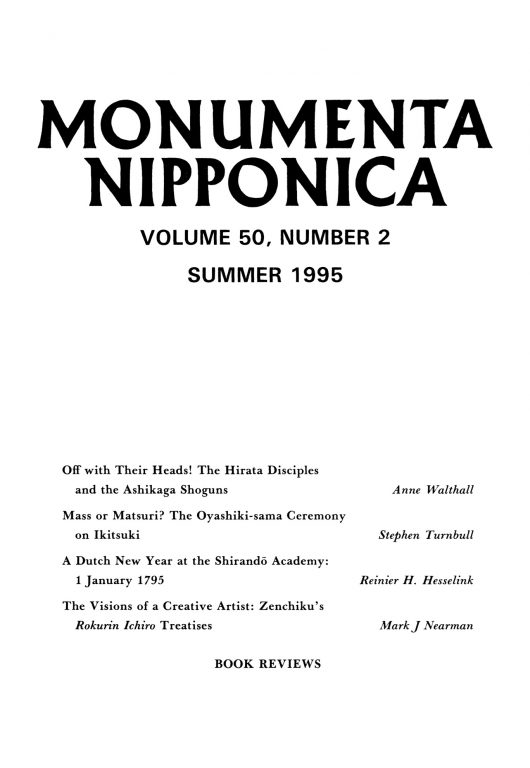 MN 50:2 (1995) 137–70Off with Their Heads! The Hirata Disciples and the Ashikaga ShogunsAnne Walthall
MN 50:2 (1995) 137–70Off with Their Heads! The Hirata Disciples and the Ashikaga ShogunsAnne Walthall MN 50:2 (1995) 189–234A Dutch New Year at the Shirandō Academy: 1 January 1795Reinier H. Hesselink
MN 50:2 (1995) 189–234A Dutch New Year at the Shirandō Academy: 1 January 1795Reinier H. Hesselink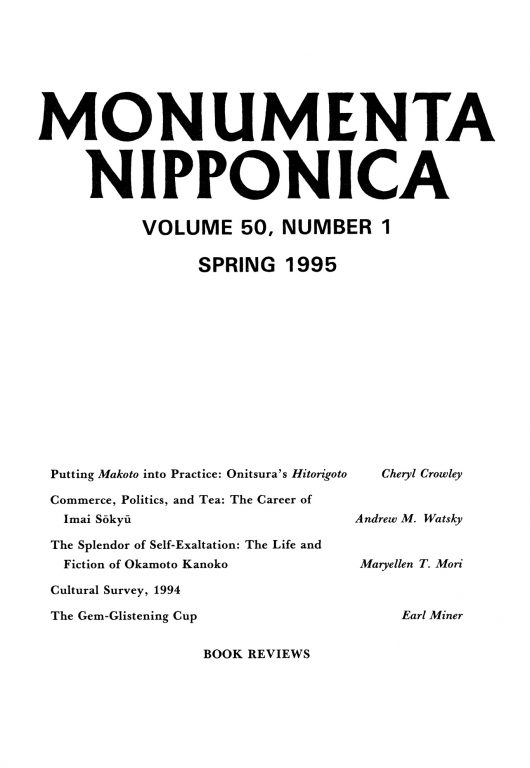 MN 50:1 (1995) 47–65Commerce, Politics, and Tea: The Career of Imai SōkyūAndrew M. Watsky
MN 50:1 (1995) 47–65Commerce, Politics, and Tea: The Career of Imai SōkyūAndrew M. Watsky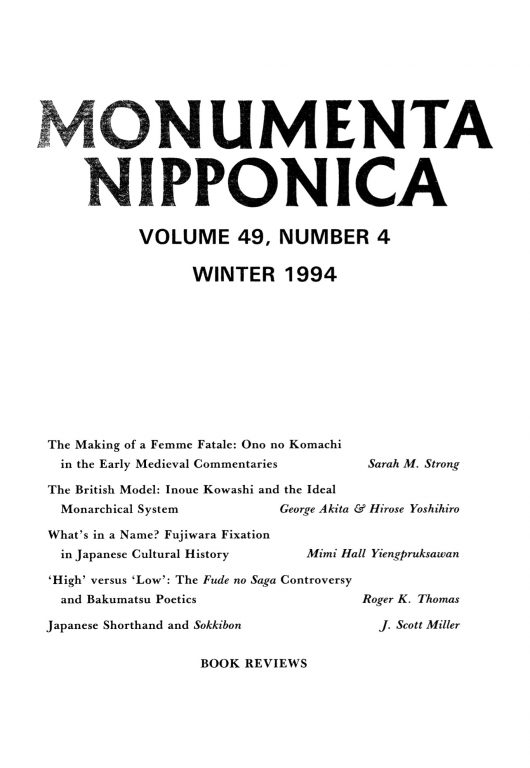 MN 49:4 (1994) 413–21The British Model: Inoue Kowashi and the Ideal Monarchical SystemGeorge Akita and Yoshihiro Hirose
MN 49:4 (1994) 413–21The British Model: Inoue Kowashi and the Ideal Monarchical SystemGeorge Akita and Yoshihiro Hirose MN 49:4 (1994) 419–21Translation of Inoue’s LetterInoue Kowashi, Translated by George Akita and Yoshihiro Hirose
MN 49:4 (1994) 419–21Translation of Inoue’s LetterInoue Kowashi, Translated by George Akita and Yoshihiro Hirose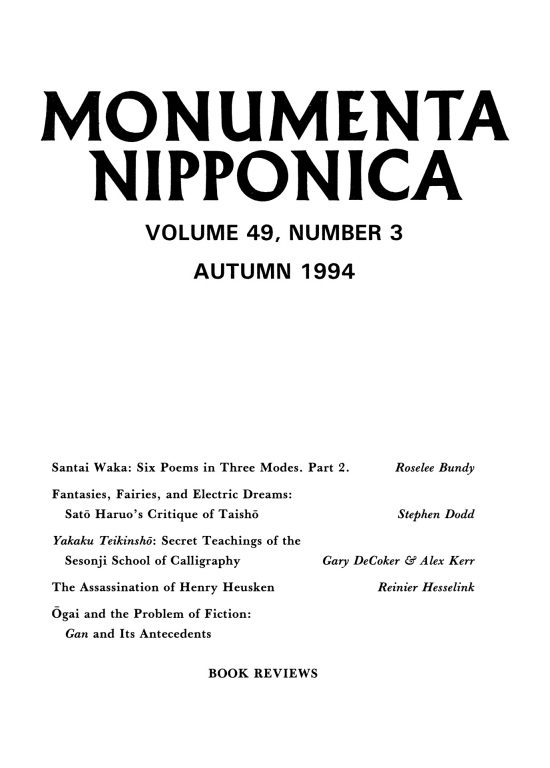 MN 49:3 (1994) 331–51The Assassination of Henry HeuskenReinier H. Hesselink
MN 49:3 (1994) 331–51The Assassination of Henry HeuskenReinier H. Hesselink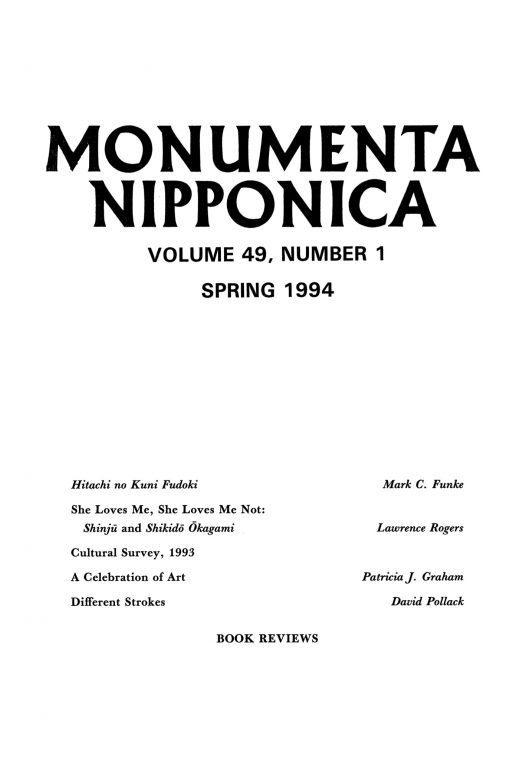 MN 49:1 (1994) 1–29Hitachi no Kuni FudokiMark C. Funke
MN 49:1 (1994) 1–29Hitachi no Kuni FudokiMark C. Funke MN 49:1 (1994) 11–29Hitachi no Kuni Fudoki (Translation)Translated by Mark C. Funke
MN 49:1 (1994) 11–29Hitachi no Kuni Fudoki (Translation)Translated by Mark C. Funke MN 49:1 (1994) 31–60She Loves Me, She Loves Me Not: Shinjū and Shikidō ŌkagamiLawrence Rogers
MN 49:1 (1994) 31–60She Loves Me, She Loves Me Not: Shinjū and Shikidō ŌkagamiLawrence Rogers MN 49:1 (1994) 40–60ShinjūFujimoto Kizan, Translated by Lawrence Rogers
MN 49:1 (1994) 40–60ShinjūFujimoto Kizan, Translated by Lawrence Rogers MN 48:4 (1993) 429–67The Meaning of Matrilocality: Kinship, Property, and Politics in Mid-HeianPeter Nickerson
MN 48:4 (1993) 429–67The Meaning of Matrilocality: Kinship, Property, and Politics in Mid-HeianPeter Nickerson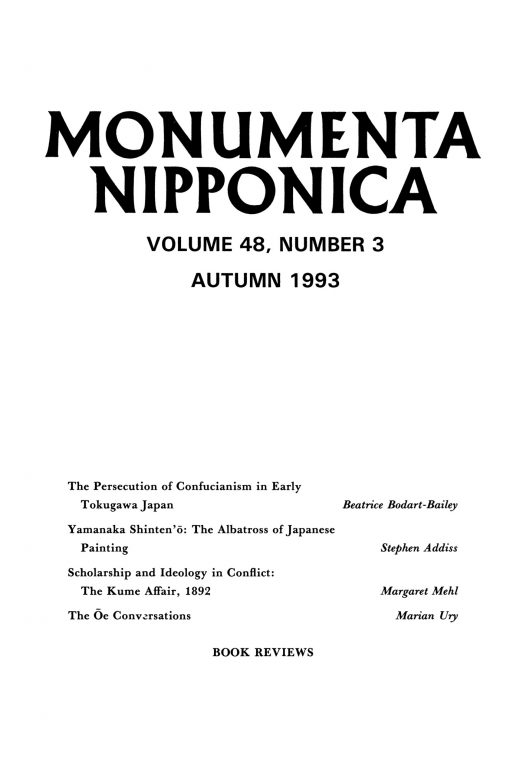 MN 48:3 (1993) 293–314The Persecution of Confucianism in Early Tokugawa JapanBeatrice Bodart-Bailey
MN 48:3 (1993) 293–314The Persecution of Confucianism in Early Tokugawa JapanBeatrice Bodart-Bailey

























